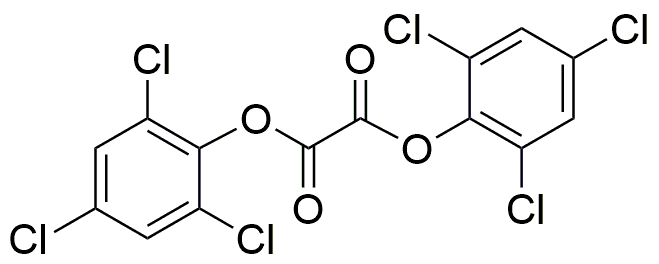Bis(2,4,6-trichlorophenyl) oxalate is widely utilized in research focused on:
- Fluorescent Dyes: This compound is used in the synthesis of fluorescent dyes, which are essential in biological imaging and diagnostics. Its ability to produce bright fluorescence makes it valuable in microscopy and flow cytometry.
- Analytical Chemistry: It serves as a reagent in analytical chemistry for detecting and quantifying various substances. Its high sensitivity allows for accurate measurements in environmental testing and quality control.
- Polymer Chemistry: The compound is employed in the development of polymer materials, particularly in creating high-performance plastics that require thermal stability and chemical resistance.
- Pharmaceuticals: In the pharmaceutical industry, it is used in the synthesis of active pharmaceutical ingredients (APIs), contributing to the formulation of effective medications with specific therapeutic effects.
- Environmental Applications: Its role in the degradation of pollutants makes it useful in environmental remediation efforts, helping to break down harmful chemicals in contaminated sites.
General Information
Properties
Safety and Regulations
Applications
Bis(2,4,6-trichlorophenyl) oxalate is widely utilized in research focused on:
- Fluorescent Dyes: This compound is used in the synthesis of fluorescent dyes, which are essential in biological imaging and diagnostics. Its ability to produce bright fluorescence makes it valuable in microscopy and flow cytometry.
- Analytical Chemistry: It serves as a reagent in analytical chemistry for detecting and quantifying various substances. Its high sensitivity allows for accurate measurements in environmental testing and quality control.
- Polymer Chemistry: The compound is employed in the development of polymer materials, particularly in creating high-performance plastics that require thermal stability and chemical resistance.
- Pharmaceuticals: In the pharmaceutical industry, it is used in the synthesis of active pharmaceutical ingredients (APIs), contributing to the formulation of effective medications with specific therapeutic effects.
- Environmental Applications: Its role in the degradation of pollutants makes it useful in environmental remediation efforts, helping to break down harmful chemicals in contaminated sites.
Documents
Safety Data Sheets (SDS)
The SDS provides comprehensive safety information on handling, storage, and disposal of the product.
Product Specification (PS)
The PS provides a comprehensive breakdown of the product’s properties, including chemical composition, physical state, purity, and storage requirements. It also details acceptable quality ranges and the product's intended applications.
Certificates of Analysis (COA)
Search for Certificates of Analysis (COA) by entering the products Lot Number. Lot and Batch Numbers can be found on a product’s label following the words ‘Lot’ or ‘Batch’.
Número de catálogo
Número de lote/lote
Certificates Of Origin (COO)
This COO confirms the country where the product was manufactured, and also details the materials and components used in it and whether it is derived from natural, synthetic, or other specific sources. This certificate may be required for customs, trade, and regulatory compliance.
Número de catálogo
Número de lote/lote
Safety Data Sheets (SDS)
The SDS provides comprehensive safety information on handling, storage, and disposal of the product.
DownloadProduct Specification (PS)
The PS provides a comprehensive breakdown of the product’s properties, including chemical composition, physical state, purity, and storage requirements. It also details acceptable quality ranges and the product's intended applications.
DownloadCertificates of Analysis (COA)
Search for Certificates of Analysis (COA) by entering the products Lot Number. Lot and Batch Numbers can be found on a product’s label following the words ‘Lot’ or ‘Batch’.
Número de catálogo
Número de lote/lote
Certificates Of Origin (COO)
This COO confirms the country where the product was manufactured, and also details the materials and components used in it and whether it is derived from natural, synthetic, or other specific sources. This certificate may be required for customs, trade, and regulatory compliance.

